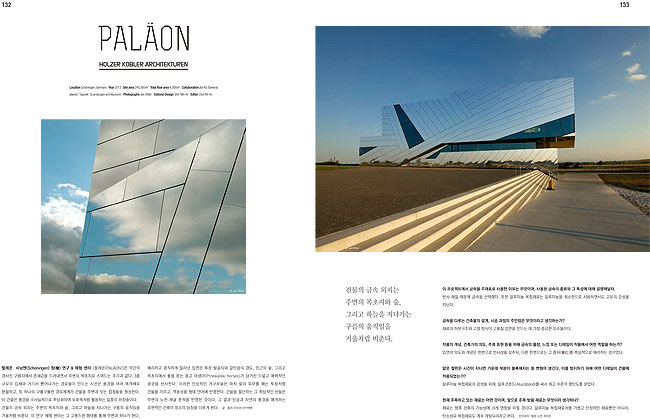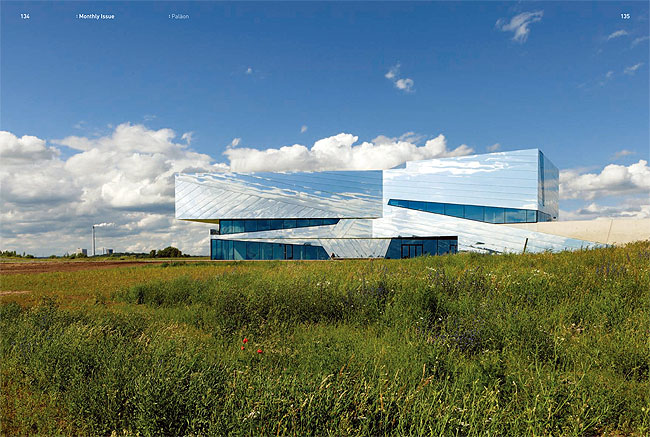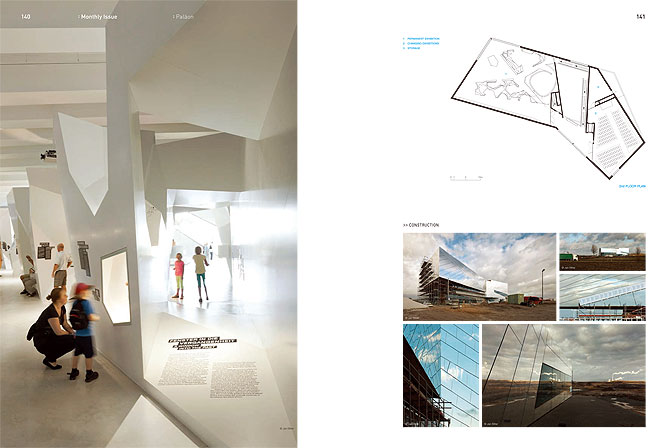PALAON
Architect :Holzer Kobler Architekturen



팔레온 쇠닝엔(Schoningen) 창(槍) 연구 & 체험 센터 <팔레온(PALAON)>은 약간의 경사진 구릉지에서 존재감을 드러내면서 주변의 목초지로 스며드는 조각과 같다. 3층 규모의 입체와 거기서 뻗어나가는 경로들이 만드는 시선은 풍경을 여러 매개체로 분할하고, 또 하나의 구불구불한 경로체계가 건물을 주변과 잇는 접점들을 형성한다. 이 건물은 풍경을 극사실적으로 추상화하여 보호색처럼 활용하는 일종의 위장술이다. 건물의 금속 외피는 주변의 목초지와 숲, 그리고 하늘을 지나가는 구름의 움직임을 거울처럼 비춘다. 이 연구·체험 센터는 그 고풍스런 형태를 통해 주변과 하나가 된다. 예리하고 큼직하게 잘라낸 입면은 투창 발굴지와 갈탄광의 갱도, 인근의 숲, 그리고 목초지에서 풀을 뜯는 몽고 야생마(Przewalski horses)가 담겨진 드넓고 매력적인 광경을 선사한다. 이러한 인상적인 개구부들은 마치 말의 피부를 째는 투창처럼 건물을 가르고, 역동성을 형태 언어에 반영한다. 건물을 절단하는 그 추상적인 선들은 주변의 노천 채굴 흔적을 반영한 것이다. 그 결과 인공과 자연의 풍경을 매개하는 표현적인 건축이 장소의 상징을 이루게 된다.
글 : 홀저 코브러 아키텍튼
이 프로젝트에서 금속을 주재료로 사용한 이유는 무엇이며, 사용된 금속의 종류와 그 특성에 대해 설명해달라.
반사 재질 때문에 금속을 선택했다. 또한 알루미늄 복합재료는 알루미늄을 최소한으로 사용하면서도 고유의 강성을 지닌다.
금속을 다루는 건축물의 설계, 시공 과정의 주안점은 무엇이라고 생각하는가?
재료의 하부구조와 고정 방식이 고품질 입면을 만드는 데 가장 중요한 요소들이다.
작품의 개념, 건축가의 의도, 주제 표현 등을 위해 금속의 물성, 느낌 또는 디테일이 작품에서 어떤 역할을 하는가?
입면의 의도와 개념은 한편으로 반사성을 갖추되, 다른 한편으로는 그 층위(層位)를 추상적으로 해석하는 것이었다. 얇은 철판은 시간이 지나면 가운데 부분이 볼록해지는 등 변형이 생긴다. 이를 방지하기 위해 어떤 디테일이 건물에 적용되었는가?
알루미늄 복합재료의 강성을 위해, 알루코본드(Alucobond)를 써서 최고 수준의 평탄도를 얻었다.
현재 주목하고 있는 재료는 어떤 것이며, 앞으로 주목 받을 재료는 무엇이라 생각하나?
재료는 향후 건축의 가능성에 크게 영향을 미칠 것이다. 알루미늄 복합재료처럼 가볍고 안정적인 재료뿐만 아니라, 탄소섬유 복합재료도 계속 개발되리라고 본다.
인터뷰이: 필립 노만 피터슨
Research & Experience Centre Schoningen Spears The [PALAON] pushes itself out of the slightly hilly topography and cuts into the forested meadows. The volume of the three-story building and the paths emanating from it form lines of sight that divide the landscape into vectors. A second winding path system forms synapses that connect to the surroundings. The building is a camouflage - a hyper realistic abstraction of the landscape. The metallic skin of the [PALAON] mirrors the meadows and forests that surround it as well as the movements of the clouds in the sky passing by. Through its archaic form, the research and experience center becomes one with its surroundings. Sharp, large formatted cuts into the building facade offer widereaching and fascinating views to the place where the spears were discovered, the pit of the brown coal mine, the nearby forest, and the Przewalski horses grazing in the meadows. The expressive openings cut into the building like spears in the skin of the horses and reflect this dynamic in the form language. The abstract cuts into the building also formally react to the neighboring traces of open cut mining. The resulting expressive architecture mediates between manmade and natural landscape and forms an emblem for the place.
Written by Holzer Kobler Architekturen
Is there any particular reason for using Metal as main material for this project? And what types of Metal have you used in this project, and what general properties do they have?
We chose the metal because of its reflective quality. The Aluminum Composite Material has an inherent stiffness while simultaneously using a minimum of Aluminium.
About what should we be careful when designing and undertaking construction with Metal?
The substructure and fastening of the material are the most important elements of a quality facade.
How did the materiality, feeling and details of Metal affect the project in terms of concept, the intention of architect and its presentation?
The intention and concept of the facade was that it on one hand be reflective, on the other hand it should be an abstract interpretation of the stratigraphy. Over time, thin steel plates undergo deformation like swelling at the center.
What details did you apply to prevent this problem?
Because of the rigidity of the aluminium composite, Alucobond provides the highest level of flatness.
What material are you looking at now? And do you think what material will get much attention in the future?
Materials will greatly influence the architectural possibilities in the future. We expect a continuing development in lightweight, yet stable materials such as aluminium composites as well as in the field of Carbonfiber composites.
Interviewee : Philip Norman Peterson
건축문화 2016년 4월호 [Monthly Issue]페이지 © 에이엔씨출판(주)